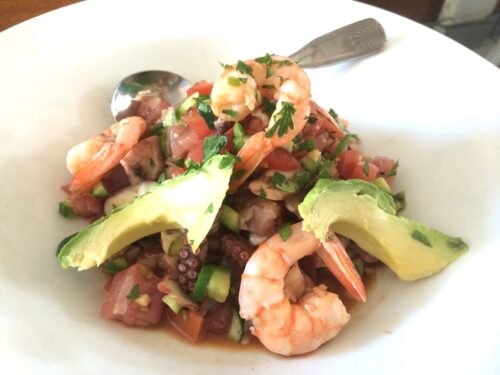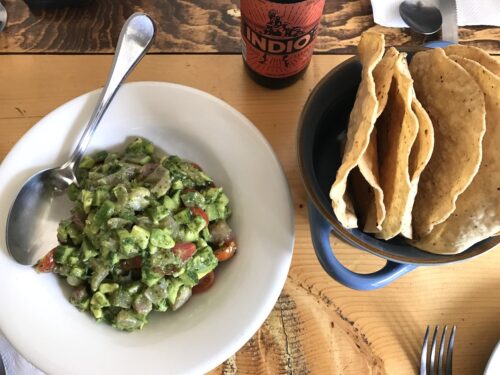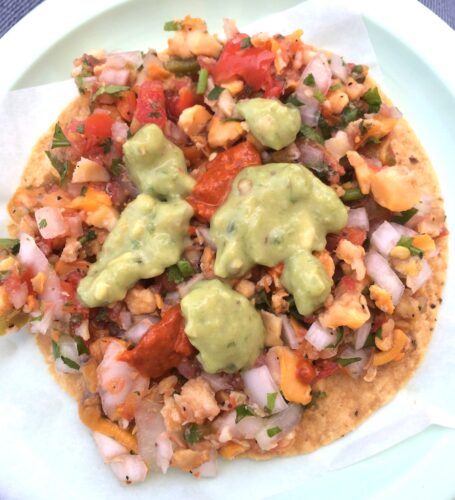Originally from South America with indigenous roots over 2,000 years old, some of the world’s best ceviche can be found today just 90-miles over the border in Ensenada, Mexico
By Chris Mejia

While only introduced to American menus in the 1980s, the popular Latin American seafood dish known as ceviche (pronounced “say-beech-chay”) has been a staple of Latin American coastal cuisine for thousands of years. In its modern-day incarnation, ceviche is prepared by curing raw fish in freshly squeezed citrus juices, usually from limes.
Several prevailing theories exist about how the word ceviche came about, yet food historians are not absolutely certain of the word’s exact origin. Spanish cookbooks from the time of settlement in the Americas contain references to both fish pickled in vinegar, known as escabeche in Spanish, and for fish marinated in the juice of bitter oranges. Ceviche is often spelled ‘cebiche’, or ‘seviche’, which could easily be a combination of the medieval Spanish word, cebo (in Latin, cibus) — a word that described fish bait or fish eaten by man or animals as food — and escabeche, which some believe travelled to South America by way of Moorish slaves accompanying Spanish Conquistadors as their cooks.
Ceviche’s origins have been traced to the Moche; an ancient South American coastal civilization that pre-dated the Incas. The Moche lived in what is modern-day Ecuador and Peru, some 2,000 to 3,000 years ago. Long prepared by Peruvian and Ecuadorian fishermen and consumed as a sort of peasant food, it wasn’t until the arrival of Japanese immigrants to South America in the 1970s that ceviche became fashionable on the menus of chic coastal eateries in Peru.
The Pacific Ocean’s cold and relatively low salinity Humboldt Current has long supplied the coastal region between Ecuador and Peru with a rich assortment of fish, shellfish, and squid. When Spanish Conquistadors first arrived in what is now Peru and Ecuador, they found that Incan cooks marinated raw fish with endemic fruits, chili peppers, and certain seaweeds. Without refrigeration, fish would have spoiled quickly in Peru’s warm and humid climate. It’s theorized that curing fish using sea salt and the juices of acidic fruits and vegetables as preservatives, allowed it to be stored longer, and thus transported and traded. Before the arrival of the Spanish, acidic fruits such as tumbo (pronounced “toom-bo”), a banana-like relative of passionfruit, and certain locally-cultivated chili peppers that were high in acid, might have been used to make an early version of ceviche.
With the arrival of Spanish colonists in the mid-1500s, lemons and limes were introduced to South America from Asia by way of Spanish and Portuguese traders. As Spanish and Incan cultures amalgamated, indigenous cooks experimented with new ingredients. These cooks paired the acidic juices from bitter oranges, lemons, and limes with fresh seafood, morphing their ancient raw seafood dish into the ceviche we know today. They found that the acid from the citrus juices added flavor and cured the raw fish faster and better than their endemic ingredients. From that point forward, the use of citrus juices became the preferred method for making ceviche.
The chemical reaction that occurs when the acid of citrus encounters fish is similar to what happens when fish is cooked using heat: the fish’s translucent flesh becomes opaque and firm. The longer fish is marinated in citric acid, the firmer it becomes. Older, more traditional, recipes for ceviche call for curing fish in citrus juice for as much as 12 to 24 hours, resulting in a rather firm (if not chewy) texture; producing a mouthfeel more like boiled chicken, rather than delicate fish.

When Japanese immigrants arrived in coastal Peru in the 1970s, they brought with them their culinary tradition of preparing and serving freshly caught raw fish, namely in the forms of sashimi and sushi. To the Japanese, it was almost considered a crime to over-cure fine cuts of fresh raw fish to the point that the fish became almost rubbery in texture and mouthfeel. To appeal to their South American clientele, Japanese cooks adapted old Peruvian ceviche recipes. Instead of over-curing fish to the point of rubber-like firmness, they opted to flash-cure the fish, serving it almost immediately after the introduction of the citrus juice. This simple adaptation allowed for the delicate nature and taste of the fresh fish flesh to be retained. With this Japanese-inspired modification, ceviche went from peasant fisherman food to chic culinary sophistication and proceeded to take the culinary world by storm.
Every Latin American country has their own version of ceviche, incorporating regional ingredients to round out the iconic dish according to local preferences. Today, almost all regional adaptations of ceviche are dressed in a base of lime juice, salt, chili pepper, and onion. In Peru, it’s often accompanied by toasted plantain chips and served with everything from sweet potato to toasted corn, and even rice in some parts. In Ecuador ceviche features tomato and occasionally peanuts in addition to its base of lime juice, onion, chilis, and salt. On the coast of Honduras, it’s often made with coconut milk.
Travel through the coastal states of Mexico and one will find many regional recipes for ceviche. One of the most common Mexican ceviche recipes incorporates a mixture of octopus, squid, mackerel, tuna, and shrimp, and is known as a “cocktail.” Cubed avocado, diced chilis, thinly julienned red onion, fresh cilantro, and salt are added to lime juice, and then combined with the raw seafood cocktail — diced tomatoes and olives are sometimes included. This traditional Mexican ceviche is customarily presented in a tall cocktail glass and the dish is accompanied by corn tostadas or totopos (corn chips) and picante (hot sauce).
Traveling to the Mexican port city of Ensenada, famed food author and TV host, Anthony Bourdain, brought world-wide recognition and fame to Mrs. Sabina Bandera in 2012 when he featured her street-cart-vended ceviche tostadas on his popular television program, Anthony Bourdain No Reservations. Upon sampling various fresh fish tostadas from Sabina’s iconic street-side ceviche cart, La Guerrerense, Bourdain proclaimed that Sabina’s ceviche tostadas were of the best street food in the world, cementing a local reputation that has endured some 60+ years.

Translated, La Guerrerense means “a person from the Mexican State of Guerrero.” A newly wed couple in 1960, Sabina and her husband followed her in-laws from their former home in coastal Guerrero, Mexico, to Ensenada, and helped establish a modest street-corner food cart to support the extended family, introducing Baja California to their family’s regionally inspired ceviche recipes and salsas. Just a few years into the endeavor, Sabina and her husband took over full-time, soon becoming a favorite stop amongst local seafood aficionados. When Bourdain filmed his Baja episode in 2012, Sabina was already well-known amongst locals; but with the airing of his show later that year, Sabina and her family business were launched into the gastronomic stratosphere of world food fame, where they have remained ever since.
Ceviche can be found throughout coastal Baja California, and without a doubt, the best ceviches are almost always prepared and served fresh from small curbside carts and stands (known in Spanish as cevicherias) that are within very close proximity to a local fishing port. As raw seafood can vary in terms of its freshness and can cause foodborne illness when not stored properly or used within a day or so of being caught, one should ask or follow the locals when choosing a cevicheria. Avoid ceviche preparations that have been made in bulk ahead of time (often found in the deli cases of supermarkets throughout Mexico); it’s best to select cevicherias that have a solid local reputation for sourcing the freshest daily catch and preparing it from scratch directly in front of you, just after you have ordered. Though most are constructed of modest building materials, the most reputable cevicherias will be very clean, and the cooks will wear facemasks and hats or hairnets.
Trustworthy Mexican cevicherias open early in the morning in the same location every day and sell out and close by the early afternoons, if not sooner. From this practice, one can deduce that these well-known businesses only deal in the freshest seafood, sourced daily from local fishermen. Look for crowds of locals ordering and eating while standing around the stand or cart; avoid cevicherias that appear solitary, no matter what “special price” is offered. In most jurisdictions, the price of every menu item must be clearly posted in plain sight. As is customary in Mexico, you will eat your share, then pay — be sure to keep track of your tab, as payment is on the honor system; tipping those who prepared your ceviche is always appreciated, but not required.
When ordering ceviche, don’t be afraid to branch out a bit from your comfort zone and ask locals what they are eating; the best ceviche preparations in Mexico often include sea urchin, sea snails, squid, shrimp, abalone, and octopus — some served raw, and some pre-cooked and chilled before serving. The seafood (mariscos in Spanish) used to make ceviche varies depending on location and season — use this handy seafood translation guide to understand what’s being offered at any Mexican cevicheria. It’s customary to add spicy chili-pepper-based salsas atop Mexican ceviches, however the seafood itself should smell and taste of the fresh salty ocean; if it smells “very fishy,” it’s probably not fresh, and should be avoided. When in doubt, follow the locals, and respect what your nose tells you.
Chris Mejia is an experienced culinary guide, food writer, and self-proclaimed “gastronomer” who has spent years exploring and curating the best of Baja California’s vibrant food scene. Follow Chris on Instagram and Facebook @MrStretchyPants.
